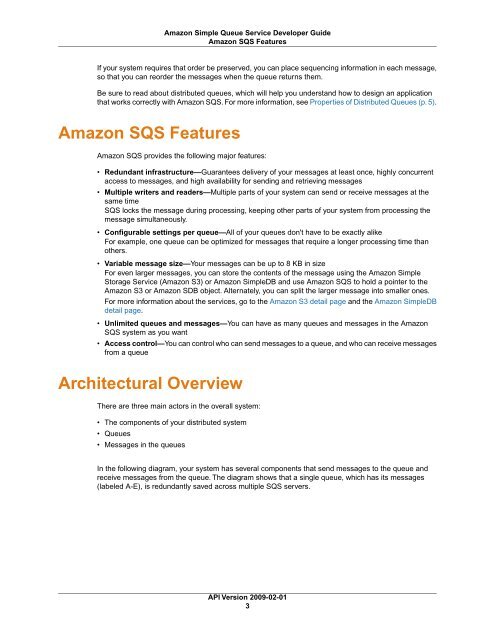sqs-dg-2009-02-01
Create successful ePaper yourself
Turn your PDF publications into a flip-book with our unique Google optimized e-Paper software.
Amazon Simple Queue Service Developer Guide<br />
Amazon SQS Features<br />
If your system requires that order be preserved, you can place sequencing information in each message,<br />
so that you can reorder the messages when the queue returns them.<br />
Be sure to read about distributed queues, which will help you understand how to design an application<br />
that works correctly with Amazon SQS. For more information, see Properties of Distributed Queues (p. 5).<br />
Amazon SQS Features<br />
Amazon SQS provides the following major features:<br />
• Redundant infrastructure—Guarantees delivery of your messages at least once, highly concurrent<br />
access to messages, and high availability for sending and retrieving messages<br />
• Multiple writers and readers—Multiple parts of your system can send or receive messages at the<br />
same time<br />
SQS locks the message during processing, keeping other parts of your system from processing the<br />
message simultaneously.<br />
• Configurable settings per queue—All of your queues don't have to be exactly alike<br />
For example, one queue can be optimized for messages that require a longer processing time than<br />
others.<br />
• Variable message size—Your messages can be up to 8 KB in size<br />
For even larger messages, you can store the contents of the message using the Amazon Simple<br />
Storage Service (Amazon S3) or Amazon SimpleDB and use Amazon SQS to hold a pointer to the<br />
Amazon S3 or Amazon SDB object. Alternately, you can split the larger message into smaller ones.<br />
For more information about the services, go to the Amazon S3 detail page and the Amazon SimpleDB<br />
detail page.<br />
• Unlimited queues and messages—You can have as many queues and messages in the Amazon<br />
SQS system as you want<br />
• Access control—You can control who can send messages to a queue, and who can receive messages<br />
from a queue<br />
Architectural Overview<br />
There are three main actors in the overall system:<br />
• The components of your distributed system<br />
• Queues<br />
• Messages in the queues<br />
In the following diagram, your system has several components that send messages to the queue and<br />
receive messages from the queue. The diagram shows that a single queue, which has its messages<br />
(labeled A-E), is redundantly saved across multiple SQS servers.<br />
API Version <strong>2009</strong>-<strong>02</strong>-<strong>01</strong><br />
3

















